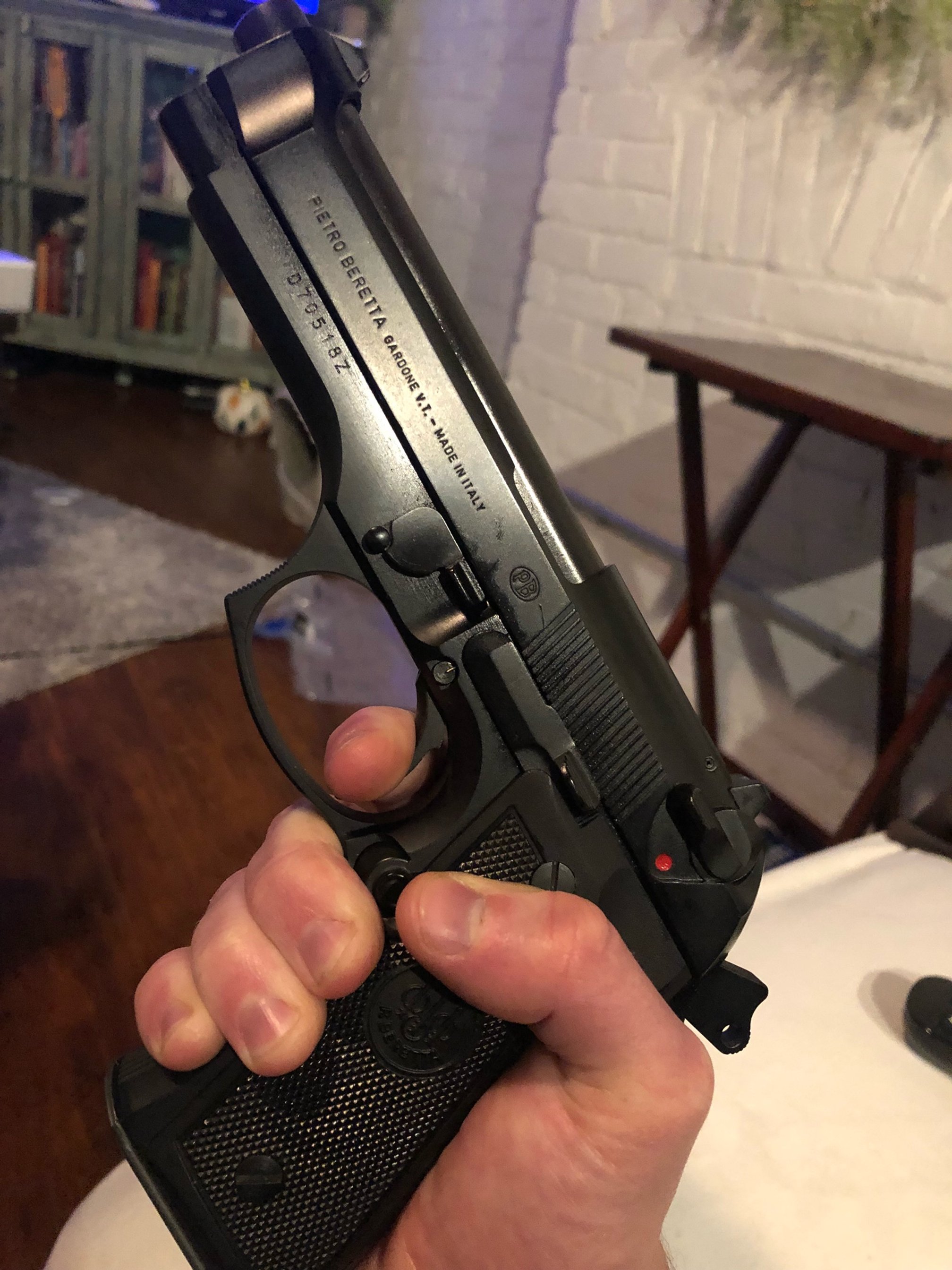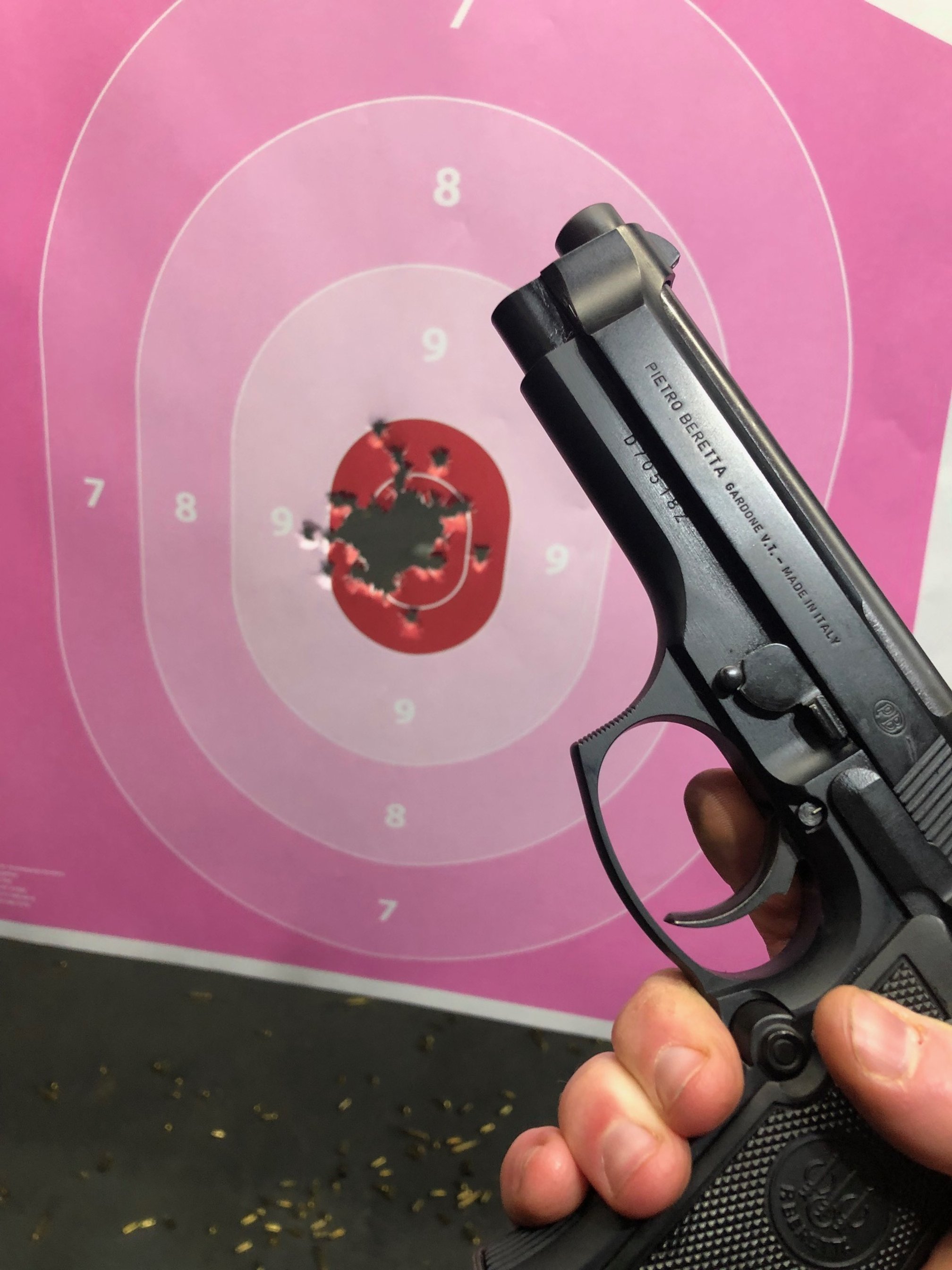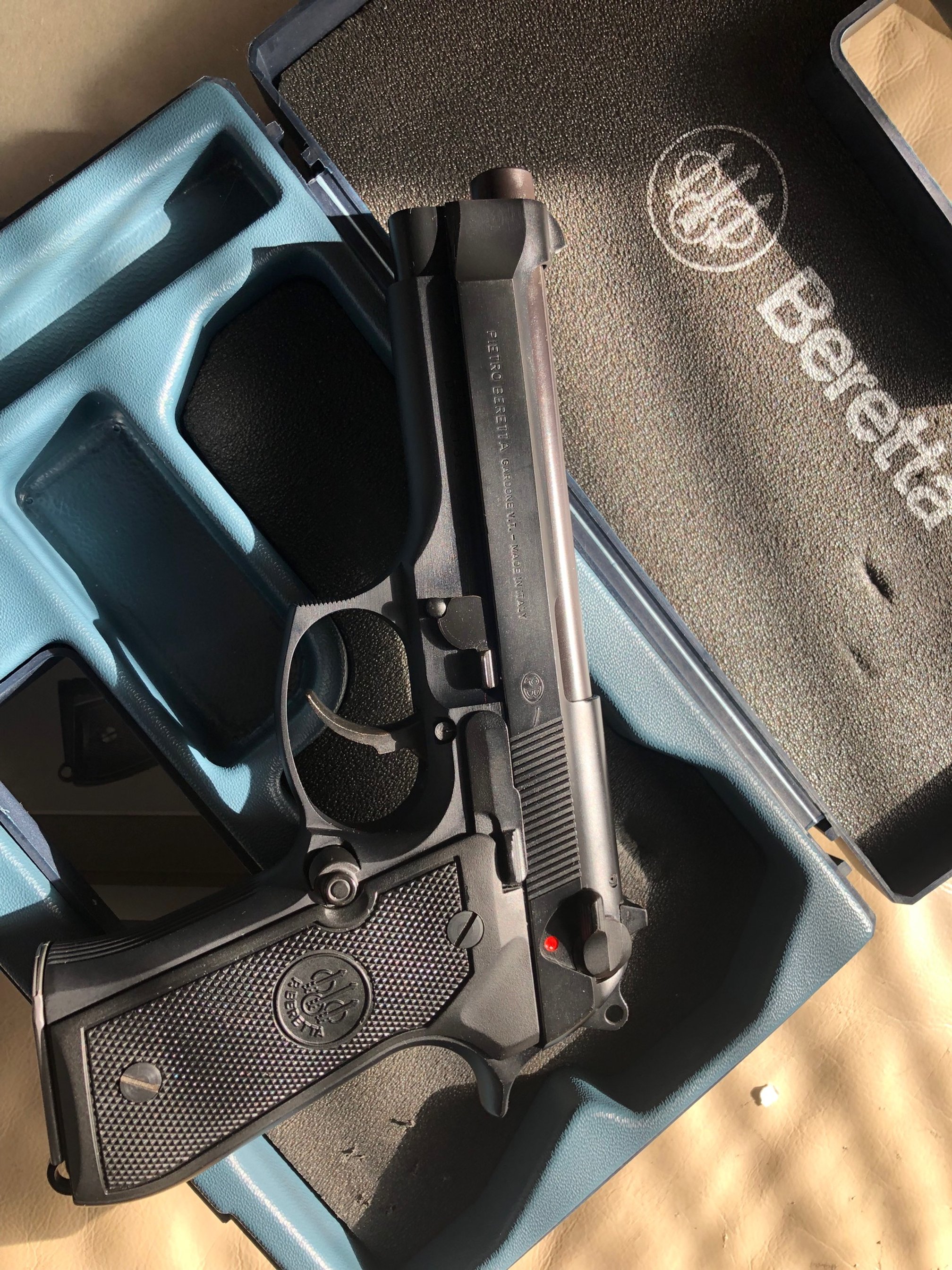Beretta 92F Review: More Than an Icon (92FS / M9)
It’s big. It’s sexy. It’s Italian.
It makes you wanna nonchalantly mutter “yippee-ki-yay-mother_____r” as you threaten a posse of nihilistic Euro-trash. It dares you to mag dump a helicopter, with your hairspray-lavished mullet rippling gently—if not gloriously—under the slightest pretenses of recoil.
It is… a legit Beretta 92F, made in 1989.
God, I love Italy.
And, until about 3 weeks ago, it was completely unfired.
So… after putting about 200 rounds and roughly $300 of collector value through my latest, umm, divestment, I can confidently tell you this: An old-school Beretta 92 is gun-hipster gold. You need one. Maybe two.
What makes the Beretta 92F hipster worthy?
The 92 isn’t just an icon—it’s a gun that shoots like no other, offering a refined sense of poise and purpose that translates into effortless accuracy.
Sure.
There are more accurate guns than a Beretta 92. But I’m not sure any other gun offers up its signature recipe for accuracy so willingly. You feel connected to every shot. Like the distance between you and your target almost disappears. It gives you punch-out-the-bullseye accuracy every time, and it doesn’t give a shit what you think about red dots, accessory rails or one-handed slide manipulations. It just wants you to peer down those iron sights and hose-down the 10-ring with as many bullets you can afford to feed it. And, it…
Doesn’t. Shoot. Freakin’. Left.
NOTE: While I offer some perspectives on how the 92F compares to more recent 92FS / M9 models, I will mainly focus on the shooting/handling characteristics of the Beretta 92 in general.
Feel Matters
It’s no secret that the 92 is… big boned. Yet, its girthy grip offers a reassuringly solid feel in the hand. And, somehow, it keeps the trigger reach pretty short—at least in single action. Even with small hands, I can comfortably engage the trigger with the distal joint of my index finger. And there’s reach to spare. Plus, the width gives your support hand plenty of “meat” to push into—so you get tons of lateral stability with the 92.
In single action, the trigger reach is ideal—even for my small hands.
As soon as you get your grip sorted out, your trigger finger finds a solid wall, right where you want it to be. You add some pressure… the ~6lb break is wonderfully crisp. It’s not quite a 1911 trigger, but it’s pretty much my gold standard for a SA trigger on a DA/SA gun.
And as soon as you feel that mechanically gratifying “thunk” of the slide reciprocating, you know…
You nailed whatever you were aiming at.
It just kinda speaks to you. The recoil impulse is satisfyingly slow, soft and linear—“smooth” is an understatement. It doesn’t pull you off target or make you flinch. It keeps you in the moment. Keeps you in the conversation. And seems to say, “Yo, I put that shot where you wanted it. What next?” Then all you’ve gotta do is line up those dots and drop the hammer. Honestly, the Beretta PX4 achieves a similarly communicative feel—albeit with entirely different method of action.
50 rounds @ 10 yards.
Reliability meets quality
I don’t have to tell you the Beretta 92 is reliable. It served the US military with distinction for over 35 years and it will probably continue to do so for the foreseeable future. It also serves the Italian military and many other foreign military units / police forces.
Sure, some Navy SEALS cracked some slides way back when. Supposedly, they were torture-testing the guns with oodles of high-pressure 9mm. Big surprise. And there were some sand issues (in Iraq) with aftermarket mags (i.e., cheapo finish, no hole near the bottom for sand egress). But, beyond these over-hyped anomalies from the past, I feel there’s a consensus that the Beretta 92 is one of the most proven, most reliable, most rugged handgun platforms out there.
As long as you keep some semblance of lubrication on the innards… a 92 will run. And it’ll probably outshoot most of its more “modern” competitors. I’ve had 4 Beretta 92s from different generations, and they’ve all been 100% reliable (minus a broken extractor spring on a surplus 92S from the early ‘80s).
My 92F came in this dope, old-school box, with the dope, old-school manual, written in dope, slightly broken English by a real Italian from the real 1980s.
And this 92F, in particular, just exudes quality (see generational differences below, for more detail on this). The finish is beautiful, albeit functional. Everything fits and functions perfectly. There are no rattles. There’s no excessive play in the slide/frame fit. And the slide famously feels like it’s on glass rails as it cycles. Which brings us to the next point…
Locking Block Talk
The 92’s unique “locking-block” system plays a big role—I think—in its inherent shootability. If you don’t know, Beretta basically copied Walther’s breech-locking action from the P38, first using it in the model 1951. In fairness, Beretta’s rendition of the system is smaller and more simplified than what you find in a Walther—but it’s definitely more of a “cover performance,” if you will. And I’m not dinging Beretta for embracing that system. It’s no more or less of a ripoff than virtually every other handgun on the planet using a Browning-inspired tilt action.
Beretta’s locking block (top) and Walther’s blocking block (from my P5). The Walther’s is beefier, whereas Beretta designed the part to be more of a “wear” item: it’s rated for ~20,000 rounds, and you just replace it before that.
In a nutshell, the locking-block (also known as “falling block”) system allows the barrel to stay straight as the gun cycles—it only moves back and forth, instead of tilting. Another way to look at it: a separate part does the tilting to unlock the barrel from the slide, instead of the entire barrel pivoting down and back.
Now, I’m no physicist… but… since the locking-block system keeps the barrel straight the as gun cycles, it would (or could) explain the more “linear feeling” recoil impulse you find in a Beretta 92. I also own a Walther P5 (which is more or less the final iteration of the P38) and I can tell you there is a definitely a similarity in how the guns handle and shoot… especially as it relates to recoil.
But it’s not all rainbows and unicorns
People bitch about the 92 being humongous.
It is. It’s freakin’ huge. But I ain’t mad about it. The weight and size (along with the locking block) are part of what make it such a great shooting gun. And it was never meant for concealed carry—it’s a duty gun, straight up. But I can’t give Beretta a pass on the double-action trigger. While the gun is simply sublime in SA, compared to competitive offerings from Sig Sauer (e.g., the P226) and Smith & Wesson, Beretta’s DA game leaves something to be desired.
With small hands, it can be hard to get enough “finger” out in front the trigger blade for a 100% straight-back pull.
The DA is long and heavy. No one’s surprised. It’s supposed to be that way. But when the 92’s hammer falls (in DA), the entire gun jerks, jostles and fishtails—and so do the sights. Now, this is partly because I have small hands: it’s tough to get enough “finger” in front of trigger for a 100% straight-back pull. But also think part of that “sight jerk” problem is because there’s more over travel in the Beretta’s DA action.
In other words, the hammer falls while you’re still plowing through the DA stroke. So, if you’re engaging the trigger at ANY kind of an angle… the gun jerks in (or against) that direction as the trigger jumps to backstop. Which, in turn, makes the sights skip off target.
Let me be clear: the distinction expressed above is—in the grand scheme of things—minor. But, comparing the Beretta’s DA pull to that of my Smith & Wesson 5906, you can see the difference in over travel. The Beretta’s trigger releases the hammer a bit farther away from the end-point of its travel, whereas the Smith’s trigger moves discernibly closer to the backstop when it releases. It’s not much—just a few millimeters. And pull itself is no lighter. But the hammer lays down soo cleanly with the 5906. The sights don’t budge.
Now, that’s not to say the DA trigger is unusable in a stock 92. Head shots at 10 yards? All day. Torso at 25? Sure. And I’ll say that this Beretta’s DA pull is definitely improving with more rounds/more dry firing. In any case, I tend to see the DA pull in a DA/SA gun as a defensive feature intended for reactive shooting under pressure; I don’t really expect to shoot DA as well as SA. Otherwise… if that was the expectation… why would they include SA on DA/SA guns?
That said, there are some good aftermarket options you can use to improve a 92’s stock DA pull:
Lighter hammer spring. Either Beretta’s own “D” spring (originally intended for their DAO guns) or a chrome-silicon spring from Wilson Combat. Definitely lightens and smooths the DA stroke. Wilson offers a range of different weights, but I’ve read that the 12-pounder is as light was want to go, lest you risk light primer strikes.
Langdon Tactical’s “Optimized Performance” trigger bar. It’s designed to reduce over travel and trigger reset. I have a Langdon OP trigger bar in my Beretta PX4C (which has the same sight-jostling issues—definitely a Beretta thing) and it does help.
Langdon Tactical’s “Trigger Job in a Bag.” This is kinda the nuclear option. Langdon sends you a sack of pre-tuned fire-control components and you switch-out the parts. I had Langdon do some work on my PX4 (not the TJIB, but, when I ordered the gun), and it was honestly too light for me. But I got in touch with Ernest himself, sent him the trigger group and he made it perfect. Great service from Langdon.
Short-Reach Trigger. These are available directly from Beretta. I actually haven’t tried one, but—as I alluded to before—I think getting “more finger” on the trigger can definitely aid in achieving a more controlled DA stroke.
Generational Differences
The technical differences between 92Fs, 92FSs and M9s have been covered to death in a gazillion other reviews and videos. Besides… if you’re a pistol hipster, you probably know all that anyway.
But, I will tell you this, one gun nerd to another: If you’re looking for an Italian-made 92, it might be worth your while to search out an F, or at least an earlier FS. While all Beretta 92s will shoot wonderfully, the newer Italian guns don’t really compare in terms of the superficial tactile and aesthetic qualities.
The Italian 92s have gradually been gaining more and more slide-etched “lawyer copy” since the mid 2000s. Current examples have what seems like an entire paragraph on each flat of the slide, combined with a very conspicuous import marking AND an ugly white-highlighted serial number. Also, Beretta Italy started using a rougher frame finish on their 92s around 2015. It’s honestly not terrible, but, it’s not as nice as what they were using before. And while the 2015 92FS Compact I had shot very well, I tend to think the overall build of the earlier guns was just a bit tighter and more sorted out. But that’s not say the 2015 felt cheap or “janky” by any means.
From what I can tell, none of the above applies to the Maryland and Tennessee 92s (and M9s). They all have clean, attractive slide markings and smoother finishes on the frames. I can’t speak to fit and feel because I’ve never owned an American-made 92 [sips Chianti, extends pinky]. But, suffice to say, if I was buying new… I’d buy American. True, it’s not as Gucci as having a legit Italian-made Beretta. But at least your gun won’t be moonlighting as a legal textbook.
Conclusions
The Beretta 92 kicks ass.
It’s elegant, yet functional. But it’s functional in a way that transcends what you’d get out of a Glock or most other “contemporary” service pistols: it’s just soo much more intuitive in how it handles and shoots. That’s a gray area, of course—and it’s my opinion. But, hey: you wouldn’t be reading this review if you didn’t want my opinion.
What are your thoughts on the Beretta 92? Experiences? Opinions? Scathing condemnations on my review? Feel free to share below…
Thanks so much for reading.
#hiptac
© 2022, Hipster Tactical







